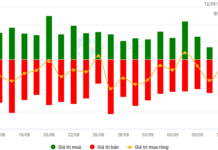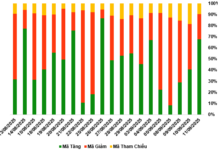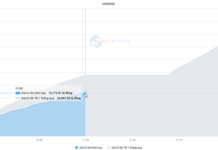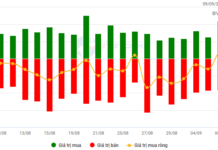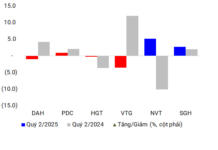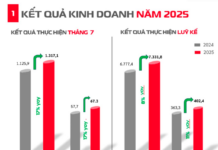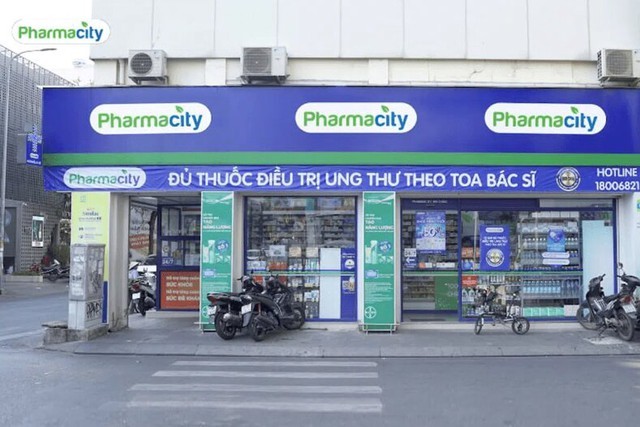Long Chau Unrivaled in Race to Market Supremacy
FPT Retail exhibits steady growth six years after entering the pharmaceutical market with its 2017 acquisition of Long Chau. Despite efforts by direct competitors Pharmacity and An Khang—including Pharmacity’s foray into prescription drugs and An Khang’s strategic store placements—they continue to lag behind.
Pharmacity is still undergoing restructuring following the departure of founder Chris Blank in 2022 after over a decade at the helm. Pharmacity’s primary investors, SK Group and Mekong Capital, have since taken a direct role in the chain’s operations. In September 2022, Tran Tue Tri was appointed as Pharmacity’s CEO, but was replaced by Deepanshu Madan just over a year later.
Over the past two years, Pharmacity has continuously opened and closed stores, with its total count fluctuating around 1,000. Additionally, Pharmacity has not disclosed financial metrics in recent years.
Recently, Pharmacity has expressed interest in conquering the prescription drug market.
In 2021, MWG entered the pharmaceutical market by acquiring the An Khang chain, following FPT Retail’s path. Initially, MWG expressed ambitions to lead the pharmaceutical market, but due to various factors, the corporation has opted to moderately develop An Khang for the past two years. The An Khang chain maintains 500 to 550 stores.
According to CEO Doan Van Hieu Em, An Khang experienced stable revenue growth until the end of 2023, but remained unprofitable. SSI Research estimates that the An Khang pharmacy chain will generate VND 2,500 billion in revenue, a 16% increase compared to 2023, and VND 2,900 billion in 2025. This equates to losses of VND 339 billion and VND 243 billion in 2024-2025, respectively; in 2023, An Khang incurred a loss of VND 343 billion.
Meanwhile, Long Chau currently leads in the number of stores, operating over 1,500 pharmacies. Regarding the OTC drug market share—both modern and traditional channels—Long Chau does not have specific figures from market research organizations, but according to their pharmaceutical partners, Long Chau accounts for 60% to 70% of their distribution to retail chains, varying by brand.
Currently, the Vietnamese pharmaceutical market is valued at approximately USD 7 billion—excluding genuine and imported products—with hospitals accounting for USD 4 billion and retail stores and pharmacies of various sizes comprising the remaining USD 3 billion. Long Chau aims to capture approximately 1/3 of this market, corresponding to USD 1 billion.
According to the plan, FPT Retail will open an additional 400 pharmacies in 2024, increasing Long Chau’s total number of locations to 1,900 and targeting revenue between VND 20,000 billion and VND 22,000 billion. In 2023, the pharmacy chain contributed half of FPT Retail’s total revenue of VND 31,850 billion, reflecting a 20% increase over the previous year.
The Secret to Rapid Growth Without Losses: Negotiating Favorable Prices and Investing in Technology
Ms. Nguyen Bach Diep – Chairwoman of FPT Retail
According to Nguyen Bach Diep, Chairwoman of FPT Retail, during the 2024 Annual General Meeting of Shareholders, the company’s large chain scale and robust technology system have enabled each Long Chau store to significantly reduce its payback period and increase sales year after year.
“Due to our extensive chain size, we can negotiate favorable prices with pharmaceutical companies, which increases our gross profit margin and helps reduce the payback period for each store. Previously, each new store needed to achieve revenue of VND 600 million to break even, but now it is only VND 450 million/month, reducing the payback period from six months to three months.
A Long Chau store requires an investment of approximately VND 800 million. Currently, Long Chau establishes approximately 40 to 50 new stores each month. With a payback period of three months, we only have 150 stores that have been open for less than three months and are not yet profitable. Furthermore, Long Chau stores typically see an increase in revenue of 10% to 20% after one year of operation,” stated the Chairwoman of FPT Retail.
Furthermore, thanks to significant investments in technology and modern advancements such as AI, machine learning, and big data over the past three years, Long Chau has improved its inventory management and reduced stock loss—a substantial challenge for retail chains, particularly in the pharmaceutical sector due to industry-specific characteristics. Long Chau has operated for six years and has amassed 13 million loyal customers, providing ample data for the implementation of these technologies.
In the past, before its technological system was fully developed, Long Chau faced difficulties in distributing products and managing inventory due to its large number of SKUs—tens of thousands—and a complex product structure (boxed pills/blister packs/liquid medications). According to Long Chau’s management, the pressure to manage inventory became overwhelming after the chain reached 1,000 stores.
The first hurdle they had to overcome was ensuring sufficient drug supplies to meet customer demand while minimizing excess or expired inventory. The second challenge was preventing accidental errors by pharmacists, which could lead to drug loss. The third challenge was maintaining Long Chau’s most competitive advantage: providing a comprehensive supply of prescription drugs for its target customer base of people with chronic illnesses.
“Presently, our technology system has been upgraded to the third generation. This enables us to provide the appropriate product catalog and quantity to each specific store—based on the right product, the right customer, and the right time—rather than stocking all tens of thousands of SKUs in every outlet. Currently, Long Chau’s stock-out rate is only 5%, indicating that we fulfill approximately 95% of the drugs requested by customers.
Regarding inventory management: pharmacists simply need to pour pills from the bottle and capture an image using the app, which integrates an AI that can accurately count the remaining quantity of drugs, eliminating the need for manual counting as was previously done. These enhancements have reduced inventory counting time for pharmacists from 2-3 days to 2-3 hours.
We have observed an increase in Long Chau’s inventory holding days each year—exceeding the 21 to 23 days typical of the ICT sector—not due to declining management capabilities, but rather to ensure adequate drug availability for customers, the expansion of our SKU range, and Long Chau’s growing contribution to the corporation

